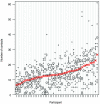Close encounters of the infectious kind: methods to measure social mixing behaviour
- PMID: 22687447
- PMCID: PMC4288744
- DOI: 10.1017/S0950268812000842
Close encounters of the infectious kind: methods to measure social mixing behaviour
Abstract
A central tenet of close-contact or respiratory infection epidemiology is that infection patterns within human populations are related to underlying patterns of social interaction. Until recently, few researchers had attempted to quantify potentially infectious encounters made between people. Now, however, several studies have quantified social mixing behaviour, using a variety of methods. Here, we review the methodologies employed, suggest other appropriate methods and technologies, and outline future research challenges for this rapidly advancing field of research.
Figures


References
Publication types
MeSH terms
Grants and funding
LinkOut - more resources
Full Text Sources

